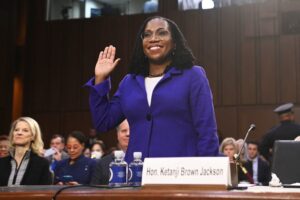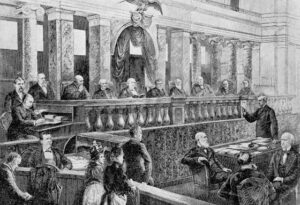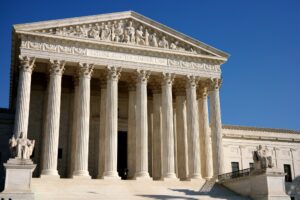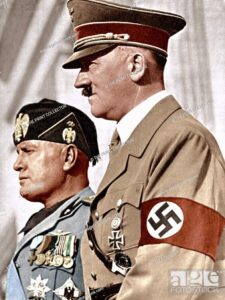
This is part 4 of the Saving the Court series. I would encourage you to read previous posts, including
- Saving the Court: Announcing the Project (Part 1)
- Saving the Court: How We Got Into This Mess (Part 2)
- Saving the Court: A History of Supreme Court Reform Efforts (Part 3)
——————————
The Constitution gives the President the power to appoint members of the Supreme Court with the advice and consent of the Senate. Most reform proposals involve changing something about the way the Court is structured or how it operates. Surprisingly few deal with how judges are nominated and confirmed. Even the Presidential Commission on the Supreme Court (PCSCOTUS) only briefly touched on the nomination and confirmation process, and that was limited to a few paragraphs in an appendix. Yet, there may be no more consequential reform than changing and improving the way Justices are nominated by the President and confirmed by the Senate.
The nomination and confirmation process is broken. Looking at a brief history of Supreme Court nominations and confirmations shows how the process has degraded over time.
For most of the history of the nation, the nomination and confirmation process for Supreme Court Justices has been a rather routine event. With few exceptions, Justices were nominated and confirmed with a minimum of drama or fanfare. This was true even when the President and the majority of the Senate represented different parties.
The first Supreme Court Justice was nominated in 1789. It was not until 1939 that a Supreme Court nominee, Felix Frankfurter, took unrestricted questions in an open setting as part of his confirmation. Nominees did not routinely sit before the Senate Judiciary Committee to answer questions until John Marshall Harlan’s nomination in 1955. These appearances mark the beginning of what we now know as the modern nomination and confirmation process.
An inflection point appears to have taken place in 1987 when President Ronald Reagan nominated Robert Bork to the Supreme Court. By all accounts, Bork was a towering legal mind with an impressive history of service as a judge on the U.S. Court of Appeals for the D.C. Circuit, as Solicitor General in the Nixon and Ford Administrations, and as an esteemed law professor at Yale University Law School. Even so, Bork was an outspoken critic of both the Warren and Burger Courts’ constitutional interpretations, especially as they related to First Amendment and right to privacy decisions. These decisions had been lauded by both moderates and liberals in the Senate, making Bork’s outspoken criticism unwelcome.
Bork was nominated to replace Justice Lewis Powell, a principled moderate. Democrats in the Senate warned the Reagan Administration that they would have a fight on their hands if they nominated a conservative like Bork. Reagan dismissed the warning and nominated Bork anyway.
According to Senator Paul Simon (D-IL), if the vote had been held prior to Bork testifying before the Judiciary Committee, he likely would have been confirmed. However, Bork willingly engaged with the Senators during the hearing, often lecturing them on legal points as if they were his students. He was gruff and stand-offish in his demeanor, rubbing several senators the wrong way. In the end, Bork was his own worst enemy. The Senate rejected him by a vote of 58-42, with six Republicans joining all but two Democrats to defeat the nomination.
It’s not like Bork’s rejection by the Senate was the first. Although it was rare, it did happen occasionally. In fact, in 1969 and 1970 respectively, Clement Haynsworth and G. Harrold Carswell, two Nixon nominees, were both rejected. However, Bork’s rejection seemed to anger and energize Republicans. They felt stung by Bork’s rejection and saw it as a turning point in Supreme Court confirmation hearings.
Even so, the next several nominations did not cause many waves. For instance, Anthony M. Kennedy was confirmed 97-0; David H. Souter was confirmed 90-9; Ruth Bader Ginsburg was confirmed 96-3; and Stephen G. Breyer was confirmed 87-9. The votes were not particularly close.
The exception to these overwhelmingly bi-partisan confirmations of Supreme Court nominations was the 1991 nomination of Clarence Thomas, between Justices Souter and Ginsburg. Thomas was nominated to replace Thurgood Marshall, one of the Court’s most liberal Justices. Thomas was an outspoken conservative, and the wide gap between his judicial philosophy and that of Marshall was a sticking point for a lot of moderate and liberal Senators, including then-Chairman of the Senate Committee on the Judiciary, Joe Biden. Those differences were overshadowed by the allegations of sexual harassment leveled by Anita Hill against Thomas. The allegations gave the hearings an undignified, overly dramatic atmosphere. In the end, Thomas was confirmed 52-48. Eleven Democrats and all but two Republicans voted to confirm Thomas.
The next two nominations—Ruth Bader Ginsburg and Stephen Breyer, both nominated by Bill Clinton—went rather smoothly. This was due, in part, to both the President and the majority in the Senate being from the same party. But after Breyer’s confirmation, things drastically changed.
Beginning in 2005 with the nomination of John Roberts to replace William Rehnquist as Chief Justice, the bi-partisan nature of the confirmation process began to breakdown. The change can be seen in the confirmation votes since 2005. For instance, Roberts was confirmed 78-22 in 2005; Samuel A. Alito, Jr. was confirmed 58-42 in 2005; Sonia Sotomayor was confirmed 68-31 in 2009, Elena Kagan was confirmed 63-37 in 2010; Neil Gorsuch was confirmed 54-45 in 2017; Brett Kavanaugh was confirmed 50-48 in 2018; Amy Coney Barrett was confirmed 52-48 in 2020; and Ketanji Brown Jackson was confirmed 53-47 in 2022.Of course, not reflected in these votes was the refusal of the Republican-led Senate to even hold a hearing on President Obama’s nomination of Merrick Garland in 2016.
Understanding Why the Confirmation Process Has Become Dysfunctional
The breakdown of the confirmation process has been a bi-partisan endeavor. Both Republicans and Democrats have escalated the rhetoric and the political maneuvering. Each successive nomination to the Supreme Court now seems to call for increased escalation in a process that has become tit-for-tat and entirely predictable.
The question of why this is happening is difficult to answer with any precision and differs depending on who is being asked. For Republicans, the escalating confirmation process warfare began with the hearings surrounding Robert Bork’s nomination. They also still hold a grudge (although many current senators were not in the Senate at the time) over the Clarence Thomas hearings. Finally, Republican’s point to the fact that Democrats—most notably, Sen. Harry Reed (D-NV)—invoked the “Nuclear option” of not allowing use of the filibuster when it came to Executive Branch, district court, and appellate nominations. Republicans point the finger squarely at Democrats when it comes to the dysfunctional Supreme Court confirmation process.
By contrast, Democrats view the rejection of Bork’s nomination as a bi-partisan effort. Robert Bork, they feel, would have been far too conservative for the Court, especially considering who he was slated to replace. They point to the way Republicans have escalated the political maneuvering, first by invoking the nuclear option of disallowing the filibuster for Supreme Court confirmation votes, then the way that Sen. Mitch McConnell (R-KY) used the process to his advantage by refusing to hold confirmation hearings in an election year on Obama nominee Merrick Garland. To add insult to injury for Democrats, McConnell turned around and held expedited confirmation hearings for Trump’s nominee, Amy Coney Barrett, literally weeks before a Presidential Election.
Both sides blame the other for delaying Supreme Court nominations, as well as other Presidential nominations. Both sides believe they are playing defense, protecting themselves from what they know the other party would do if given the chance. The truth is, they are both right.
It is important to remember that of the nine current Justices on the Supreme Court, six were appointed by Republican Presidents, despite Democrats winning the White House in five of the nine Presidential Elections that took place during the same timeframe as those appointments. To make matter even worse, Democrats won seven out of nine popular vote majorities in those Presidential Elections. In other words, while the country as a whole was voting overwhelmingly Democratic, Republicans were filling the Court with overwhelmingly conservative Justices. This has created a legitimacy crisis for the Court, and it is the confirmation process that is most squarely to blame for the crisis. We can either address the symptoms of the crisis with proposals to enlarge the Court, implement term limits for Justices, strip the Court of some of its jurisdiction, etc. or we can deal head-on with the nexus of the crisis: the confirmation process.
According to Benjamin Wittes, Senior Fellow in Governance Studies at The Brookings Institution and author of the book, Confirmation Wars: Preserving Independent Courts in Angry Times, “Put simply, there would be no significant debate about court reform and enlargement today, except in certain academic circles, but for the confirmation process. There is no grave problem with the courts that requires reform. Rather, the perception of the need for change is driven by the disruption of a long-term equilibrium in the manner in which judges and Justices are named and seated on the bench.”
The prognosis is not good. If we do not treat the disease of a dysfunctional confirmation process, the escalation we have seen in the past will move outside of the confirmation process and impact the structure and procedures of the Court itself. According to Wittes:
“The simple reality is that we have run out of possible escalations within the narrow confines of the mere treatment of nominees. We have already reached the point at which a nominee can expect unanimous or near-unanimous opposition from the party not in control of the White House—irrespective of his or her qualifications. We have already reached the point at which a nominee cannot count on a vote at all in the event that the Senate is not controlled by the same party as the presidency. And we have already reached the point where a nominee can expect aggressive and swift confirmation, even late in an election year, in the event of united control—the minority’s dilatory tactics having been gutted. In other words, the work has already been done to ensure a perfectly partisan confirmation process; there are no more norms left to violate in that space. The areas remaining for escalation all involve questions outside of the four corners of that process: the number of seats available to fill on a court, for example, the jurisdiction of the courts, their budgets, and whether their judges are subject to impeachment for votes that members of Congress don’t like. Of these available battlefields, the size of the courts is the most immediately responsive to the current concern with the court’s ideological balance.”
Wittes is right. The legitimacy crisis the Supreme Court is currently facing begins, and could potentially end, with reform of the confirmation process. If the confirmation process could be reformed, there would be little need for Court enlargement, term limits for Justices, or most of the other reform proposals this paper will be examining. That’s not to say that the other reform proposals are not good ideas. On their own merits, implementation of some or all of the proposals may make sense. But when it comes to the current legitimacy crisis, only reform of the confirmation process is capable of curing the disease that has led to the crisis.
A Plan to Reform the Confirmation Process
Jeffrey Peck, former Special Counsel, General Council, and Staff Director of the Senate Judiciary Committee from 1987-1992 was in an especially privileged position to view the confirmation process up close, seeing both the good and the bad. He testified before the Presidential Commission on the Supreme Court of the United States and offered a reform plan that deals with five areas in particular that need to be reformed:
- Time frames that must be followed by the Judiciary Committee and the Senate;
- Scope of questioning allowed of any Supreme Court Nominee;
- The role the FBI can and should play in investigating a nominee’s background;
- The discretion the Judiciary Committee should have over the testimony of third-party witnesses; and
- Rules surrounding Senate consideration and vote on confirmation.
Peck’s plan was created after speaking to twenty-five different Senators or senior staff members—thirteen Republicans and twelve Democrats—who had experience with the confirmation process. The purpose of the proposed changes to Senate rules is to add uniformity to the confirmation process, make it fairer for all stakeholders, and to limit or eliminate the partisan maneuvering that has taken place in the past 25-30 years.
Below in italics is Peck’s proposal. My thoughts are listed in the “Discussion” section after each element of Peck’s proposal.
- Time Frames: By Standing Rule of the Senate or Rule of Procedure of the Senate Judiciary Committee, the following time frames and procedures should be adopted and implemented:
a) Hearings shall commence no sooner than 30 days and no later than 50 days after the Senate receives the nomination. If the nomination is made during a Senate recess that is longer than three days, the minimum and maximum periods shall be extended by the length of the recess.
b) The nominee’s complete written record shall be delivered to the Committee no later than 10 days before hearings begin. Delays in the production of materials shall extend the minimum and maximum periods by the length of the delay, thereby penalizing the nominating Administration for dragging its feet. The White House Counsel shall certify when production of materials has been completed.
c) The Committee shall vote on the nomination no sooner than 10 days and no later than 21 days after hearings conclude. The “official” conclusion of the hearings shall be determined by the Chair and Ranking Member; any “gaming” of the hearings for the sole purpose of extending the time frames should be avoided. The current ability of one Senator to “hold over” a nomination shall be eliminated.
d) The Committee shall be required to report the nomination to the floor in all circumstances – even with a negative recommendation or without recommendation. The Constitution places the advice and consent obligation on the Senate, not a committee of the Senate. The Judiciary Committee processes the nomination by holding hearings, preparing a report and reporting the nomination to the Senate. It should not determine the fate of the nominee.
e) The full Senate shall begin consideration of the nomination no sooner than 10 days and no later than 21 days after the Committee formally files its report on the nomination. The Senate can delay consideration only by unanimous consent.
f) The time frames in this new Rule could be shortened or lengthened “for cause” by joint agreement of the Judiciary Committee’s Chair and Ranking Member. “Cause” includes, but is not limited to, a voluminous record of the nominee due to extensive writings, speeches or opinions, the need for investigation of new matters and/or if additional relevant materials are uncovered.
g) These timeframes shall apply under all circumstances, including nominations in a presidential election year up to August 1 of that year, as explained below.
h) These new Rules could be altered only by unanimous consent of the Senate in order to eliminate the ability of the majority party to jettison the new policies for political expediency by simple majority vote.
i) These new Rules are needed now and, ideally, should be adopted and implemented immediately. Unfortunately, there is little or no chance of that occurring. Accordingly, the new Rules proposed here shall not take effect until after the next presidential election and not until the swearing in of the new Congress in January 2025. Postponing the effective date of new rules should reduce the partisanship over their deliberation and increase the likelihood of adoption because neither party would know who the rules theoretically help, and who they theoretically hurt, by the time they go into effect.
Discussion: There are three things that stick out to me about this section of Peck’s proposal. First, the specific time frames Peck lists are badly needed. Never again should the Senate Majority Leader—just one elected official out of 100 members of the Senate—hold up a president’s nomination to the Supreme Court. By doing so, he in essence unilaterally reduced the number of sitting Supreme Court Justices from nine to eight for an entire Court calendar year. Senate rules should be implemented to make sure that no single member of the Senate can have that much power.
Second, every person nominated to the Supreme Court should get an up or down vote by members of the entire Senate. The Constitution gives the entire Senate the “advise and consent” power, which has traditionally involved a simple majority vote of all Senators. No committee, including the Judiciary Committee, should have that power.
Third, I have no problem with there being a cut-off for Supreme Court nominees during the fourth year of a president’s term. Presidential nominations to the Court made by August 1 of that final year of a President’s term seems like a reasonable date. It takes into account the amount of time the confirmation process should take while also factoring in the early voting that takes place in many states.
2. Scope of Questioning: While it is not feasible to establish a Senate or Committee Rule defining the allowable scope of questioning, the appropriate norm for questioning SCOTUS nominees – a “standard of responsiveness” – should be “philosophical particularity,” as opposed to “pinpoint specificity seeking pledges or commitments” or the “extreme reluctance” taken by more recent nominees. Procedurally, no Member of the Committee, including the Chair or Ranking Member, should be allowed to instruct a nominee not to answer a question. A Member or Members may dislike the questions posed by a colleague, but it is up to the nominee to decide whether to answer.
a) To make an informed decision and fulfill their constitutional obligation and duty to exercise “advice and consent” on judicial nominations, Senators must understand the nominee’s judicial philosophy and views on core constitutional principles.
b) The so-called “Ginsburg Rule” cited by recent nominees is neither a rule nor an appropriate tactic to utilize to deflect substantively appropriate questions. Indeed, then Judge Ginsburg did not always follow it during her hearings.
c) When presidents campaign on promises regarding the justices they will appoint to the Supreme Court, criticizing past rulings and individual Justices – as they increasingly do – the Senate can hardly sit idly by during the hearings and not probe the judicial philosophy of nominees selected to fulfill those promises and answer those critiques. Indeed, the imperative to question nominees on judicial philosophy is even greater under such circumstances.
Discussion: There is a delicate balance that takes place during confirmation hearings for nominees to the Supreme Court. Senators want to know where the nominee stands on any number of issues that are likely to be debated before the Court in the near term. On the other hand, nominees to the Court do not want to fence themselves in, indicating they’ll rule one way, but ultimately ruling another.
Ideally, questions from Senators and answers from nominees will remain in the philosophical realm and will not wander into past decisions or actual future cases. The Senate has a job to do in advising and consenting on a given nominee, and they must know a little something about the nominee’s thoughts and feelings on certain salient issues. Short of stating that ideal, the rules should not restrict a Senator from asking a certain specific-type of question nor should they prohibit a nominee from answering any given question in the way they feel most appropriate in answering. Nominees should not be encouraged to avoid questions, either by the rules or by Senators from either party.
3. The Role of the FBI. Processes pertaining to the FBI’s investigation of SCOTUS nominees should be further clarified and memorialized in a Memorandum of Understanding that updates and replaces the 2009 MOU executed by President Obama’s White House Counsel and the then Senate Judiciary Committee Chair and Ranking Member. This MOU should be adopted at the beginning of a new Congress so that it is done outside the context of any particular nomination, and should:
a) Underscore and memorialize the independence of the FBI, stating specifically that the FBI’s client is the American people. It is important to make clear, formally, that when the FBI conducts its investigations neither the White House Counsel nor the Senate Judiciary Committee majority or minority are the clients.
b) Create communication protocols governing the FBI’s dialogue with the White House and the Chair/Ranking Member of the Judiciary Committee so that each of those three parties receives information simultaneously when the FBI has determined that a matter warrants investigation. It is necessary to take steps ensuring neither receives preferential treatment over the other.
c) Spell out the parameters of the FBI’s role in conducting the background investigation before the hearings begin and any subsequent investigations that arise once the hearings have started. Specifically, and working with FBI leadership, the MOU should require a more fulsome investigative process at the outset so matters that have historically come to light later in the process are more likely to be uncovered on the front end.
d) Set an expected time frame for the delivery of the FBI report for the original investigation and any subsequent investigations, with room for potential adjustments depending on the precise nature of allegations that arise.
Discussion: The FBI has an important role to play when investigating the background of a Supreme Court nominee. The investigation should be thorough, but it should not turn into a fishing expedition, and, above all else, it should not become partisan. The Chair and the Ranking Member of the Judiciary Committee should set out their expectation to the FBI up front and should give the FBI a reasonable amount of time to conduct a thorough investigation.
The purpose of setting expectations up front and making sure that the Chair and Ranking member are on the same page is so we never have a repeat of what happened during the confirmation hearings for Brett Kavanaugh, when Republicans tried to limit the scope of the FBI’s investigation into charges of sexual assault against Kavanaugh at the same time Democrats were calling for an expansion of the investigation. The FBI should remain independent, and the Memorandum of Understanding should do everything possible to make certain they do not get stuck in the middle of a partisan squabble.
4. Third Party Witnesses: Qualitative or quantitative limits on the live testimony of third-party witnesses should not be established by rule.
a) The Supreme Court plays a vital role in our nation and third-party witnesses should have the opportunity not only to submit written statements for the record but also testify in person.
b) A norm should be established whereby the majority of outside witnesses should provide well-informed assessments of the record of the nominee.
c) The Chair and Ranking Member should utilize their joint discretion, as they do in all hearings, to manage the number of witnesses.
d) The American Bar Association should no longer play the dominant role it has in reviewing nominees. The Committee should place equal weight on multiple bar associations without affording a lead role to any single one.
Discussion: I agree with Peck’s position on third-party witnesses. The Chair and Ranking Member should have discretion over who and how many parties they allow to testify live versus submitting written testimony. A wide cross-section of Americans should have a say in who is confirmed to the Supreme Court. However, time is limited and only the most relevant third-party presenters should be allowed to appear live as part of a confirmation hearing.
5. Senate Consideration and Vote on Confirmation: If we had the good fortune to write on a blank slate, Senate Rules should require 60 votes to confirm a Supreme Court Justice in order to force, at least in most circumstances, a bipartisan consensus not only on the back end, for the final vote, but also on the front end, by necessitating more consultation by the president with the minority party leadership in the Senate. But the slate is not blank; far from it. It is inconceivable that Democrats will restore a 60-vote margin for SCOTUS nominees after a Republican president and Republican Senate confirmed one-third of the Justices sitting today by majority vote. Bipartisan consensus on this issue is simply not attainable. Accordingly, I recommend:
a) The Senate should retain the current simple majority requirement for confirming Supreme Court nominees.
b) The Senate should add a new Rule explicitly requiring that all nominees receive a Senate Judiciary Committee hearing, a Committee vote and an up-or-down vote on the merits in the Senate. No nominee should be refused consideration unless the nomination has been withdrawn.
c) The Senate should consider all nominations in a presidential election year except for those made after August 1. Nominations before August 1 are likely to be completed prior to Election Day in a balanced and orderly manner. Given the time frames proposed for new Rules guiding the Judiciary Committee’s consideration, nominations after August 1 are not likely to be considered thoroughly and fairly before the American people select the next president. Key steps by the Administration and the Senate – including document production, requests for more investigative work by the FBI, number of third-party witnesses and the like – are more likely to be colored by politics and game-playing when taking place within 90 days of a presidential election. Fairness and responsible decision-making will ensue when presidential politics is not the main driver.
d) Using August 1 as a cut-off date in a presidential election year also takes into account the early voting – either by mail or in-person – that many states now allow. There are few more consequential decisions made in our nation than placing one of nine Justices with life tenure on the Supreme Court. Doing so while tens of millions of Americans are voicing their preference about the next president is anti-democratic.
e) Despite the August 1 cut-off date, any Senator who believes nominations made before that date in a presidential election year are still too close to Election Day can vote against the nomination solely for that reason.
f) While not likely feasible to implement by Senate rule, the two parties should share an understanding that nominations made by a lame duck president after his or her defeat on Election Day will not be considered.
Discussion: I disagree with Peck’s contention that Supreme Court nominees should be confirmed by at least 60 members of the Senate. There are two reasons for my position.
First, requiring 60 votes gives the minority the ability to control Supreme Court confirmations, giving their “no” votes more weight than the “yes” votes of the majority. Rather than encouraging bi-partisanship, I fear that it will create gridlock, and could potentially throw the Supreme Court into chaos.
Second, the 60-vote requirement would simply be institutionalizing the filibuster under another name. In specific areas throughout the Constitution, the Founders chose to require a supermajority vote, such as Presidential veto overrides, Constitutional amendments, and treaty ratification. They did not make a supermajority vote requirement to confirm Supreme Court Justices and we should not raise the bar in this regard now.
Of course, Peck concedes that requiring 60 votes now is not realistic, so he drops the requirement. I agree with him that it is unrealistic, but I also believe it is unnecessary and unwise.
Implementing these changes to the nomination and confirmation process would help to fix many of the ills creating the Court’s legitimacy crisis. In my next post, I’ll tackle one of the most popular Supreme Court reform proposals: expanding the size of the Court.

 This is part 3 of the Saving the Court series. I would encourage you to read previous posts, including
This is part 3 of the Saving the Court series. I would encourage you to read previous posts, including
 The Supreme Court term ended this past week with the announcement of several controversial decisions. Along with the end of the term came word that the court’s approval rating had hit an all-time low. To be sure, Americans are not supportive of many of the decisions being made by the court. But more importantly, they are not happy with the way the court is reaching those decisions, or how the justices are conducting themselves outside of court.
The Supreme Court term ended this past week with the announcement of several controversial decisions. Along with the end of the term came word that the court’s approval rating had hit an all-time low. To be sure, Americans are not supportive of many of the decisions being made by the court. But more importantly, they are not happy with the way the court is reaching those decisions, or how the justices are conducting themselves outside of court. I was in my fifties the first time I ate at a Waffle House. Until then, Waffle House, to me, was a place where addicts, the homeless, and the down-and-out ate. I know that doesn’t make sense. Heck, generally speaking, the homeless don’t normally eat their meals in restaurants. I don’t mean to besmirch anyone. I just didn’t think Waffle House restaurants were for me. Boy, was I wrong.
I was in my fifties the first time I ate at a Waffle House. Until then, Waffle House, to me, was a place where addicts, the homeless, and the down-and-out ate. I know that doesn’t make sense. Heck, generally speaking, the homeless don’t normally eat their meals in restaurants. I don’t mean to besmirch anyone. I just didn’t think Waffle House restaurants were for me. Boy, was I wrong.
 If you’ve never heard of T.J. Newman, you can be forgiven. Until fairly recently, T.J. was a flight attendant. To be more precise, she was a flight attendant with a dream. T.J. wanted to be a writer. In her spare time–and at times while she was working as a flight attendant–T.J. wrote a novel about a pilot who has to choose between purposely crashing his plane, killing everyone onboard, or having terrorists kill his family. It seemed like a great plot idea. Agents disagreed. Forty-one agents turned her down. Many of them didn’t even bother to read her writing. Forty-one rejections.
If you’ve never heard of T.J. Newman, you can be forgiven. Until fairly recently, T.J. was a flight attendant. To be more precise, she was a flight attendant with a dream. T.J. wanted to be a writer. In her spare time–and at times while she was working as a flight attendant–T.J. wrote a novel about a pilot who has to choose between purposely crashing his plane, killing everyone onboard, or having terrorists kill his family. It seemed like a great plot idea. Agents disagreed. Forty-one agents turned her down. Many of them didn’t even bother to read her writing. Forty-one rejections. The word “fascism” gets thrown around a lot these days. Often, when someone uses the word, they use it incorrectly. The truth is, most people don’t actually know what the word “fascism” means. They often use the word to describe someone or something they don’t like, but “fascism” has an actual definition. And in many cases, that definition is much different than what people think it is.
The word “fascism” gets thrown around a lot these days. Often, when someone uses the word, they use it incorrectly. The truth is, most people don’t actually know what the word “fascism” means. They often use the word to describe someone or something they don’t like, but “fascism” has an actual definition. And in many cases, that definition is much different than what people think it is. I was probably fourteen or fifteen years old when I had my first taco. It was made with seasoned ground beef on an Old El Paso hard taco shell, garnished with onions and shredded cheese, then smothered in Old El Paso Taco Sauce. For the next several years, I was under the impression that the tacos my mother made for our family were the only kind of tacos in the world. I was naïve.
I was probably fourteen or fifteen years old when I had my first taco. It was made with seasoned ground beef on an Old El Paso hard taco shell, garnished with onions and shredded cheese, then smothered in Old El Paso Taco Sauce. For the next several years, I was under the impression that the tacos my mother made for our family were the only kind of tacos in the world. I was naïve.